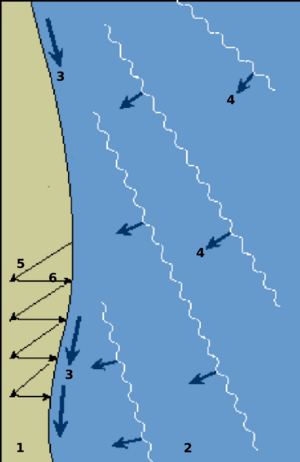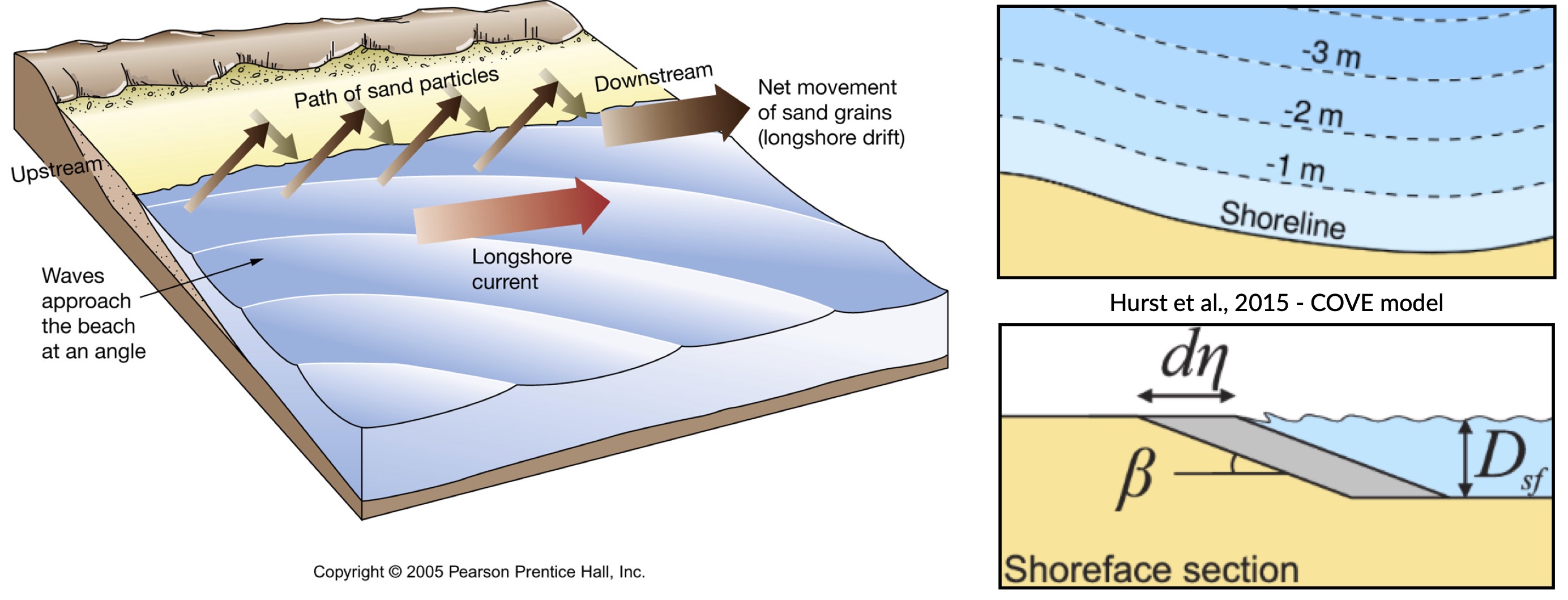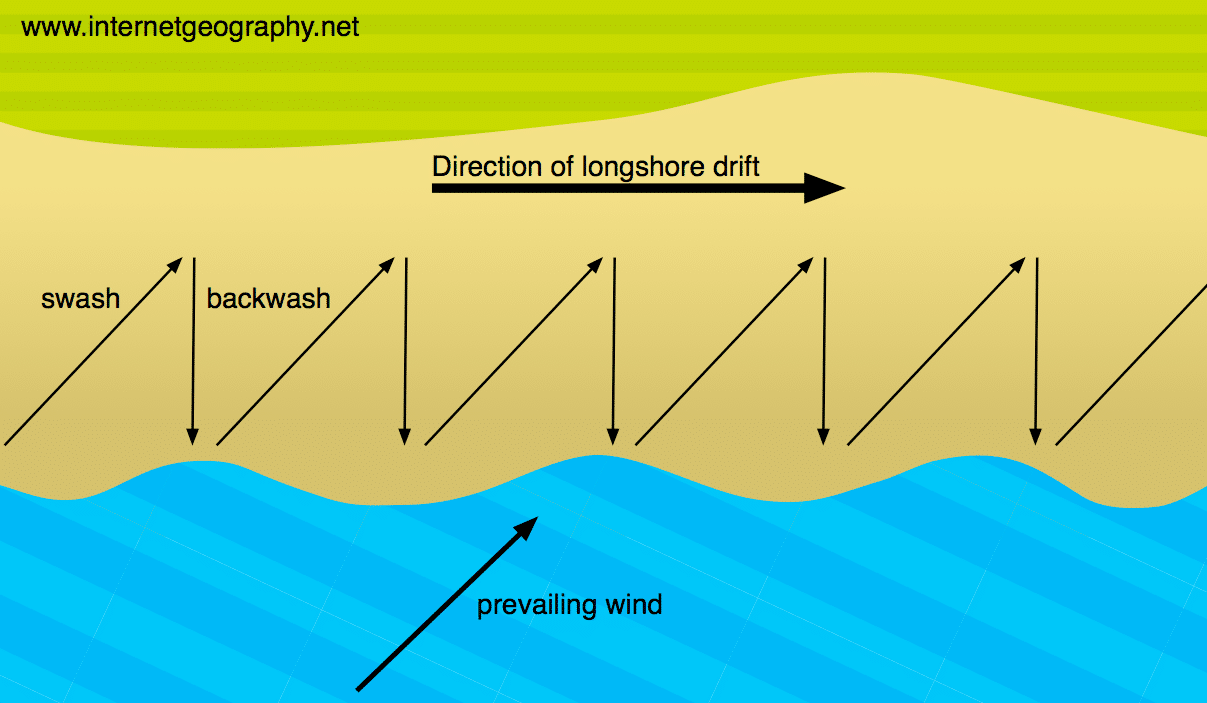Describe the Process of Longshore Drift
Up to 24 cash back Longshore drift This is the net lateral transport of material along the coastline when waves approach the coast at an angle. Material will move up the beach at an angle with the swash then straight back down the beach with the backwash.

Longshore Drift Facts For Kids
During the swash waves moving up the beach sediment is transported up the beach at the same angle as the waves swash.

. Long shore drift is the process of deposition and transportation where sediment zig-zags along a coastline. Mud banks may occur in high-energy wave-exposed settings where large volumes of mud are supplied to the mouth of large rivers. Longshore drift is a process of transportation that shifts eroded material along the coastline.
Longshore drift is a process responsible for moving significant amounts of sediment along the coast. 3 In Figure a below why are the wave crests curved. Thus longshore drift north west of the Amazon and around Bohai Bay downdrift from the Yellow River enables mud-shoal deposition in open-water settings.
Longshore drift always moves in the direction of the main wind. The Gravitational pull of the sun and Gravitational pull of the moon 2X sun Gravitational pull causes stretching on the. Longshore drift is a geological process responsible for transporting sediments such as shingle silt clay and sand along a coast that is aligned to the shoreline relying on prevailing oblique winds.
This occurs when the prevailing wind hits the shoreline and an angle or the waves are deflected. The swash waves moving up the beach carries material up and along the beach. Waves approach the coast at an angle.
2 In a similar fashion describe how the process of wave refraction can affect the sand along a shoreline. Sediment is carried by the waves along the coastline. The process of longshore drift is waves hit up against the sand and the sand grains are taken by the waves back into the sea and back to shore again this is.
B Describe the factors that affect whether sediment is eroded transported or deposited by flowing water and explain how each factor influences erosion transport and deposition. This usually occurs in one direction as dictated by the prevailing wind. What is the process of longshore drift.
Longshore drifts can cause spits at the mouth of rivers and can build barrier beaches or barrier islands. For example the prevailing wind along the Holderness Coast is north-easterly. The prevailing oblique winds send water down the coast generating a water current which in turn advances parallel to the coast.
The longshore current is part of the longshore transport that moves sand and sediment down the coastline but there is also another process that contributes to the longshore transport called beach. Swash carries sediment up. The backwash however carries the material back down the beach at right angles 90 as this is the steepest.
When a longshore current moves particles in a zigzag pattern this is called a longshore drift. Over time the material will move along the beach in a zig-zag. Author jonnowales Fun Trivia.
This method gradually carries debris along the shore. Organic secretions What causes tides. Coastal processes on the Gold Coast Longshore drift Longshore drift is the movement of sand along the coastline.
The material is first pulled into the currents by the backwash the water going out to sea and is then pushed back up the beach by the swash the water going onto the beach. The prevailing wind the direction the wind ususally blows from causes waves to approach the coast at an angle. A longshore current moves water and deposits sediment parallel to the shoreline.
Describe the process of longshorelittoral drift 4 marks Small materials are picked up and carried by seawater. Longshore littoral drift is the movement of material along the shore by wave action. Muddy coasts are associated with the lowest energy environments.
Explain why some coasts are more affected by erosion than others and describe the formation of coastal erosional features including stacks arches cliffs and wave-cut platforms. Under these conditions waves break at an angle to the shoreline forming oblique waves and the sand is. The current is called longshore current.
Longshore drift can be either a benefit or a hazard dependent on the circumstances. Longshore Drift Assignment 1. Backwash transports debris down the beach at right angles.
As the result waves break on to the beach obliquely at an angle of around 45 degrees. A Describe and explain with sketches the process of longshore drift. Incoming swash transports sediment up the beach at an angle movement contains an up-beach component and a lateral component Gravitational backwash then transports sediment back down the beach at 90 to the coastline.
This is then deposited. Changes in water level 2. The narrower blue arrows show the current that develops as a result of the waves hitting the coastline at an angle.
Describe the origins of longshore currents and longshore drift. The transport of sand and pebbles along the coast is called longshore drift. The thicker blue arrow represents the waves approaching the shoreline at an angle.
List the seven principle processes that are responsible for shaping shorelines. Waves approach the coast at an angle. It happens when waves approach the beach at an angle.
The backwash waves moving back down the beach carries material back down the beach at right angles. Longshore drift is the process of waves being dragged in by the current and eroding and affecting the coastline of Britain. Describe in words or a diagram your understanding of the process of wave refraction.
The movement of the material is known as longshore drift. Elsewhere mud flats are. Longshore drift is the process of the ocean currents forcing sand and other material down a beach.
The swash carries the sand and pebbles up the beach at the same angle usually 45º. Waves hit the coastline at an angle. - test your knowledge in this quiz.
This movement of sand is influenced by the surf zone currents created by waves and the predominant wave direction. Earth Sciences questions and answers. Describe what happens to a beach when a wall is built that obstructs the longshore drift.
The movement of sand along the shoreline is known as beach drift. Longshore drift occurs when waves travel at an angle towards the shoreline.

What Is Littoral Drift The Sandshed

Features Of Longshore Drift Youtube

Explain The Process Of Longshore Drift 3

Deposition By Waves Ck 12 Foundation

Lesson 3 Waves And Coastal Landforms Objective To
What Has Been The Dominant Direction Of Longshore Drift In The Past Along Deal Beach A Level Geography Marked By Teachers Com

Coastal Landforms Ls Explain The Formation Of Erosional Coastal Landforms Using Vast Key Words Describe The Process Of Longshore Drift And Describe The Ppt Download

What Causes Long Shore Drift Littoral Drift Annotated Diagram And Explanation Youtube

Coastal Processes 5 Transportation And Deposition Teleskola

What Is Longshore Drift Internet Geography

What Is The Difference Between Longshore Current And Longshore Drift Pediaa Com
4 What Are The Different Types Of Work The Waves Do Along Coast Lines St Paul S Senior School

Coastline Evolution Notes Coastal Processes Environments Systems
Gcse Unit 2 Notes On Coastal Landscapes A Processes 1a Types Of Wave Constructive And Destructive Describe The Characteristics Of The Two Wave Types Explain Their Impact On Beach Profiles The Differences Between Destructive Waves And

Comments
Post a Comment